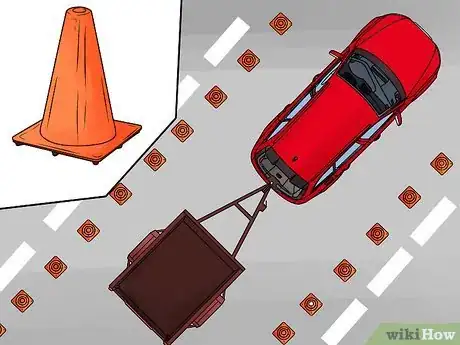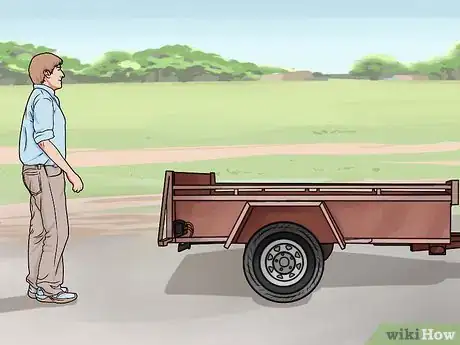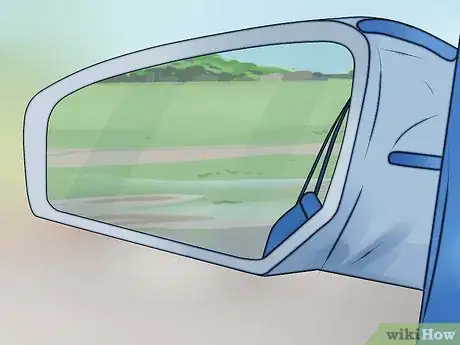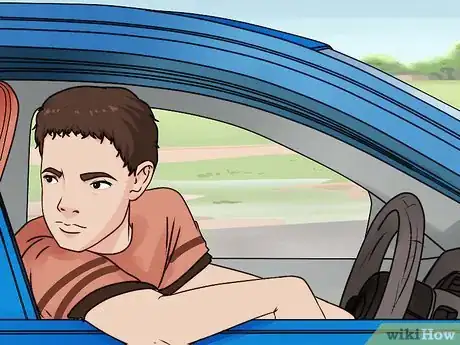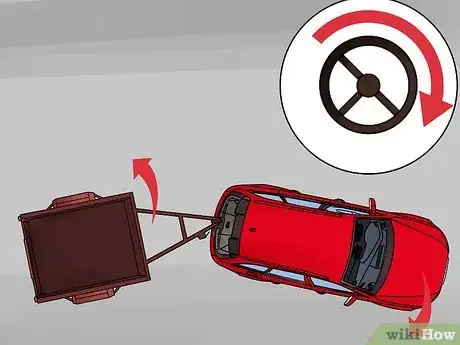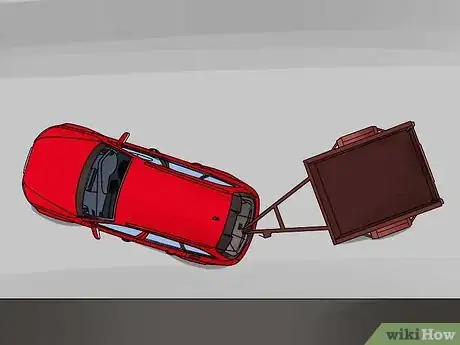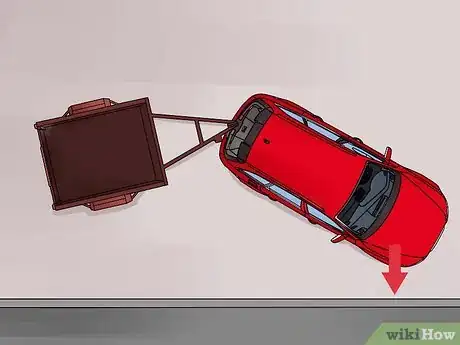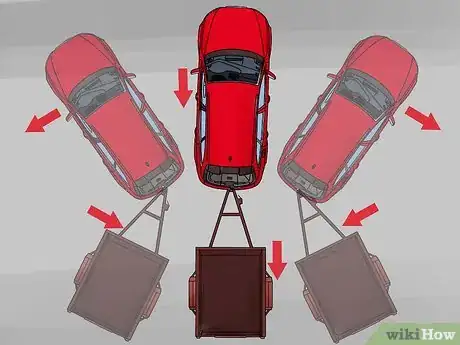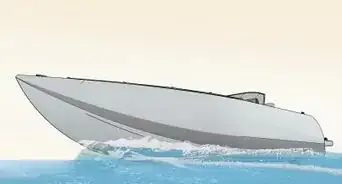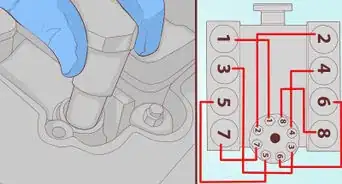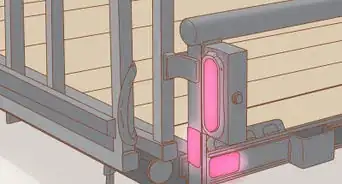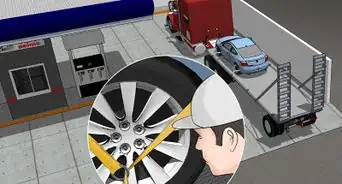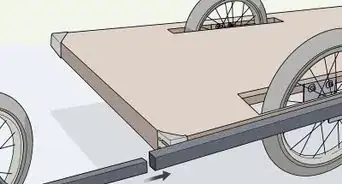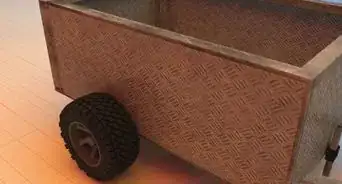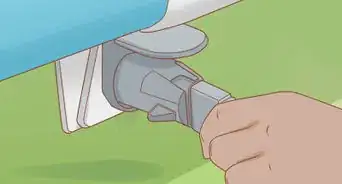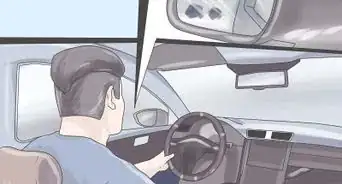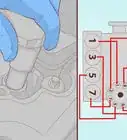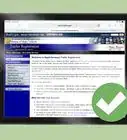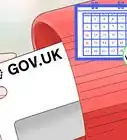This article was co-authored by Bruce Storrs. Bruce Storrs is a Driving Instructor and the President & CEO of North County School of Driving in San Marcos, California. With more than 31 years of experience, he specializes in teaching teens and adults safe driving behaviors in the classroom, online, and behind the wheel. Bruce earned a BA and MA from San Diego State University.
wikiHow marks an article as reader-approved once it receives enough positive feedback. This article received 24 testimonials and 100% of readers who voted found it helpful, earning it our reader-approved status.
This article has been viewed 788,502 times.
Backing up a car can sometimes be a stressful experience. When you have something attached to your car, it gets even more nerve wracking. However, backing (reversing) a trailer is relatively simple, especially with a little practice. As long as you understand the concept of what you're going to do ahead of time, the process is easy.
Steps
Preparing to Back Up Your Trailer
-
1Devise a strategy. Recognize that backing up a trailer requires preemptive motion of the towing vehicle to move the trailer in the correct direction. A pre-planned route is required, keeping in mind the direction of the trailer, the direction of the towing vehicle, any object in the immediate vicinity of the driving path, and the relative motion between all involved objects.
-
2Practice in an empty space such as a parking lot. Buy some small orange cones to help spot you. Try learning with a long trailer, and then attempt a small trailer. Whenever you are learning be sure to take it slow. [1] Short trailers are more maneuverable and responsive, thus more difficult to reverse. Longer trailers are more forgiving of mistakes, but will take more work to get around a corner.Advertisement
-
3Get a spotter. [2] A spotter may be helpful as another pair of eyes behind the trailer will be able to see things you (as the driver) cannot. You can even invest in a set of short-range 2-way radios. This will make communications a lot easier than yelling and/or trying to watch a spotter.
- The spotter needs to remember to look up! It's easy to become so preoccupied with obstacles on the ground that you forget to check overhead for tree limbs and wires. Always watch for leaning trees you may miss the base of the trunk just fine, but if that tree is leaning toward your trailer, it will take a bite out of your rig high up on the roofline!
-
4Adjust your mirrors. It’s going to be very important that you can see behind you, since you’re going backwards with a big rig attached to your truck. Make sure that the mirrors are adjusted so that you can clearly see the rear of the trailer.[3]
-
5Try to set yourself up so that you’re backing up towards the driver's side of your vehicle. [4] You will be able to see the rig and the site much better in your driver's side mirrors and can also glance back over your shoulder and see the rear of the rig. If you need to drive a loop around the campground to be able to approach the spot on your left side, then do so!
-
6Place one hand on the steering wheel and turn your body and head to look behind you and at your trailer. Put place your right hand on the bottom of the steering wheel (6 O-Clock position). That way when you’re ready to move you’ll simply move your hand in the direction that you want the rear of the trailer to go! Try it! If you use this hand position, it will all but eliminate turning the wheels the wrong way while backing up.
Backing Up Your Trailer
-
1Turn the wheel to the right to make the trailer go left (as you are looking toward the front of the vehicle). Another way to look at it is, the bottom of the steering wheel directs the trailer. Facing backwards tends to help the backwards feel of steering the trailer. [5]
- If you need to turn the trailer around a corner, steer the trailer toward the corner. Then you must steer slightly in the opposite direction to maintain the turning angle.
- Get out and make sure that you are in the proper position before continuing.
-
2Back the trailer to the driver's side (e.g. to the left in a left-hand drive car) not the passenger side, which is harder to see. The most common backup is a right angle.
-
3Pull past as you approach the space and turn right to the middle of the road. This is assuming that you are attempting a left-hand drive. Now turn the vehicle sharply left, so that you are positioned at an angle. You should be at less that 180 degrees on the left hand side as if you have been driving forwards around a left hand bend.
-
4Place your hands at the bottom of the wheel. As you reverse adjust the steering wheel to keep the trailer traveling in the right direction. Remember to go slow. Don't be afraid to step out of the vehicle and check out the progress you've made. There's not use trying to do it in one try to keep your pride if you end up wrecking your trailer. [6]
- It is important not to get the truck and trailer jackknifed, so do not let the turn go too far. Ideally, you can back into the space in one smooth motion. You almost always will have to stop, pull forward to achieve a more straight reverse.
-
5Back up and pull forward as often as necessary until your trailer is in place. Sometimes the hardest part of the process is having many people watch you. Try not to stress out if there are a lot of people checking out your progress. They aren’t invested in the outcome, and you are. Keep your focus.
Community Q&A
-
QuestionIs it easier to back up with a rear camera?
 Community AnswerIt definitely helps align the tow hitch on the vehicle with the trailer and is another piece of information to help prevent jack-knifing, but it doesn't help much with the overall view. You'll still want a spotter or two to help out there.
Community AnswerIt definitely helps align the tow hitch on the vehicle with the trailer and is another piece of information to help prevent jack-knifing, but it doesn't help much with the overall view. You'll still want a spotter or two to help out there. -
QuestionHow do I learn to back a triple axle trailer?
 Paul SowaCommunity AnswerIt would be the same as a two-wheeled trailer. Just remember that it's probably longer, and heavier.
Paul SowaCommunity AnswerIt would be the same as a two-wheeled trailer. Just remember that it's probably longer, and heavier. -
QuestionCan a hard turn of the tractor move the trailer when doing the alley docking?
 Paul SowaCommunity AnswerYes; however, radical moves of the truck creates radical moves of the trailer. Slow and easy is your best bet. Don't be in a hurry, and don't worry about other trucks or traffic.
Paul SowaCommunity AnswerYes; however, radical moves of the truck creates radical moves of the trailer. Slow and easy is your best bet. Don't be in a hurry, and don't worry about other trucks or traffic.
References
- ↑ http://www.livinlightly.com/how-to-backup-a-travel-trailer-like-a-pro/
- ↑ http://www.livinlightly.com/how-to-backup-a-travel-trailer-like-a-pro/
- ↑ http://www.livinlightly.com/how-to-backup-a-travel-trailer-like-a-pro/
- ↑ http://www.livinlightly.com/how-to-backup-a-travel-trailer-like-a-pro/
- ↑ http://www.artofmanliness.com/2012/02/06/how-to-back-up-a-trailer-like-a-man/
- ↑ http://www.artofmanliness.com/2012/02/06/how-to-back-up-a-trailer-like-a-man/
About This Article
To back up a trailer, place one hand on the steering wheel and turn your body and head to look behind you. Next, turn the wheel to the right to make the trailer go left so you can back the trailer to the driver's side. Pull past the parking space, turn right, and then turn left sharply so that you're positioned at an angle. Finally, shift into reverse and back slowly into the space, adjusting the wheel as needed to keep the trailer traveling in the right direction. For tips on making final adjustments before parking, read on!

